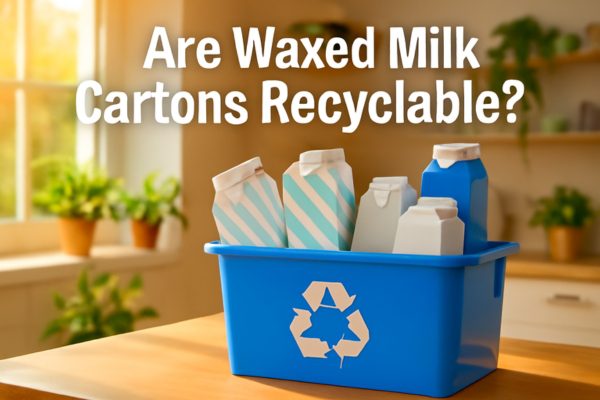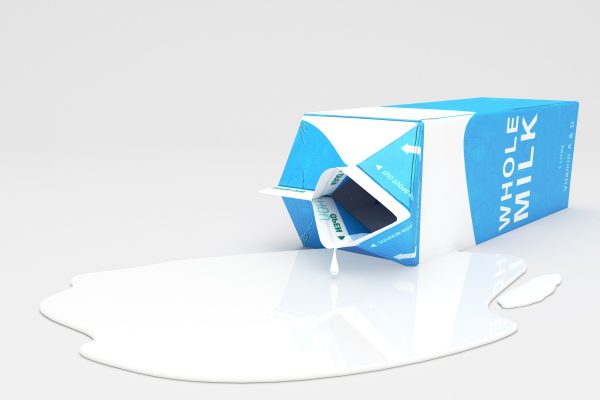

You’re standing at the recycling bin, empty milk carton in hand, wondering if that waxy-feeling coating means it belongs in the trash. Here’s the surprising truth: modern milk cartons are recyclable, and they haven’t contained actual wax for decades.
Yes, those “waxed” milk cartons can go in your recycling bin in most areas. What feels like wax is actually a thin polyethylene plastic coating that’s fully recyclable through proper processing facilities. Currently, 62% of U.S. households have access to milk carton recycling programs.
This comprehensive guide will reveal the truth about milk carton composition, explain exactly how to recycle milk cartons properly, and help you find recycling options in your area. You’ll also discover which cartons can’t be recycled and learn about eco-friendly alternatives.

The term “waxed carton” is a linguistic fossil from the early 20th century. Before the 1940s, milk cartons were indeed coated with paraffin wax to prevent leakage and protect the paper from moisture.
This wax coating created numerous problems. It made recycling nearly impossible, as the wax would contaminate paper pulping systems. The coating also had temperature limitations, becoming brittle in cold and soft in heat.
The terminology stuck even after manufacturers switched to better materials. Many people over 40 remember their parents calling them “wax milk cartons,” perpetuating the misnomer through generations.
Today’s milk containers recyclable design consists of multiple engineered layers. The primary structure is paperboard, making up 80% of refrigerated cartons. A thin polyethylene plastic coating provides the moisture barrier.
This plastic layer is heat-sealed to the paperboard during manufacturing. Unlike wax, polyethylene maintains its properties across temperature extremes and can be separated during recycling processes.
Shelf-stable cartons include an additional aluminum layer for extended preservation. These aseptic packages contain approximately 74% paper, 22% plastic, and 4% aluminum by weight.
The distinction between polyethylene and wax coatings is crucial for milk carton recycling. Polyethylene is a thermoplastic polymer that can be melted and reformed repeatedly without losing its properties.
| Feature | Polyethylene Coating | Wax Coating |
|---|---|---|
| Recyclability | Yes – separates cleanly | No – contaminates pulp |
| Temperature Stability | -40°F to 200°F | Limited range |
| Moisture Barrier | Excellent | Good initially, degrades |
| Environmental Impact | Recyclable/recoverable | Landfill only |
Wax physically bonds with paper fibers, making separation impossible. Polyethylene forms a distinct layer that specialized equipment can remove during the recycling process.
Gable-top cartons are the peaked-roof containers found in refrigerated dairy sections. These milk carton recyclable packages consist of paperboard with polyethylene coating on both sides.
The design allows for easy pouring and resealing. Most importantly for recycling, these cartons contain no aluminum, simplifying the material recovery process. The Carton Council reports that gable-top cartons have the highest recycling rates among beverage containers.
Common brands using gable-top designs have partnered with recycling facilities nationwide. This collaboration ensures consistent processing standards and market development for recovered materials.
Aseptic cartons enable milk storage without refrigeration. These packages incorporate aluminum foil between plastic and paper layers, creating an oxygen and light barrier.
The additional materials make recycling more complex but not impossible. Modern facilities use specialized equipment to separate all three components efficiently. Each material stream finds new uses in manufacturing.
Many consumers don’t realize these shelf-stable containers belong in the same recycling stream as refrigerated cartons. Both types follow identical preparation steps before recycling.
Understanding the differences helps consumers make informed choices about eco-friendly packaging. Both options offer recycling opportunities, but their environmental impacts differ significantly.
Paper Cartons:
Plastic Jugs:
The manufacturing process for paper cartons produces 70% fewer greenhouse gas emissions than plastic jug production. However, plastic jugs enjoy broader recycling infrastructure support.
Yes, you can recycle waxed milk cartons in most areas, despite the misleading name. The polyethylene-coated cartons are fully recyclable through standard paper recycling streams in communities with updated facilities.
Currently, 62% of U.S. households have access to carton recycling through curbside or drop-off programs. This represents dramatic growth from just 37% in 2011, thanks to industry investments and consumer demand.
Finding where to recycle wax coated milk cartons starts with checking your local recycling guidelines. Many curbside programs now accept these containers alongside other paper products.
Major recycling companies like Waste Management and Republic Services have expanded carton acceptance. Urban areas typically offer more options than rural communities, though coverage continues expanding annually.
Drop-off locations provide alternatives when curbside collection isn’t available. Many grocery stores, schools, and community centers host carton recycling bins through partnerships with local waste management.
Infrastructure limitations prevent universal carton recycling access. Older materials recovery facilities lack the specialized equipment needed to separate polyethylene from paperboard efficiently.
Economic factors also influence program availability. Facilities need sufficient volume to justify equipment upgrades and operational changes. Rural areas often struggle to collect enough cartons for cost-effective processing.
Market demand for recovered materials affects program viability too. Without buyers for separated polyethylene and paperboard, facilities cannot sustain recycling operations regardless of technical capabilities.
Not all cartons belong in recycling bins. Understanding these distinctions prevents contamination and ensures successful recycling efforts.
| Recyclable Cartons | Non-Recyclable Cartons |
|---|---|
| Milk cartons (all sizes) | Ice cream cartons |
| Juice boxes | Frozen food boxes |
| Cream containers | Take-out containers |
| Broth/soup cartons | Butter boxes |
| Non-dairy milk cartons | Wax-paper cups |
| Egg substitute cartons | Foam egg cartons |
Learning how to recycle waxed milk cartons properly starts with simple preparation steps. Empty the carton completely, pouring out any remaining liquid to prevent contamination during processing.
These preparation steps take seconds but significantly improve recycling efficiency. Clean cartons process faster and produce higher-quality recovered materials.
Many well-intentioned recyclers inadvertently reduce program effectiveness through simple errors. Flattening cartons ranks as the most common mistake, despite seeming logical for space-saving.
Mixing non-recyclable frozen food containers with milk cartons contaminates entire batches. The freezer-resistant coatings on ice cream and frozen dinner packages require different processing than standard milk cartons.
Removing caps creates unnecessary litter problems. Modern recycling equipment handles attached caps efficiently, keeping small plastics within the controlled recycling stream.
Including food-contaminated cartons causes additional issues. While light milk residue is acceptable, cartons used for non-dairy purposes should stay out of recycling bins.
The recycling journey transforms old milk cartons into valuable new products. At materials recovery facilities, cartons get sorted from other recyclables using optical scanners and manual inspection.
Baled cartons travel to specialized paper mills equipped with hydrapulpers. These massive blenders use water and agitation to separate polyethylene and aluminum from paper fibers.
Products made from recycled cartons include:
The polyethylene gets processed into plastic lumber for outdoor furniture and decking. Aluminum from aseptic cartons returns to manufacturing for new products.

Every recycled milk carton contributes to significant environmental benefits. Processing recycled materials requires 74% less energy than creating products from virgin resources.
Landfill diversion represents another crucial impact. Americans use approximately 50 billion beverage cartons annually, creating substantial waste without recycling programs. Each ton of recycled cartons saves 3.3 cubic yards of landfill space.
Forest conservation benefits from carton recycling too. Recovering paper fibers reduces demand for virgin pulp, protecting forest ecosystems and biodiversity. One ton of recycled cartons saves approximately 17 trees.
The transformation process showcases modern recycling technology at its finest. Cartons arriving at paper mills first undergo quality checks to remove obvious contaminants.
Hydrapulping technology separates materials through precise water pressure and screening systems. Paper fibers float while plastics and aluminum sink, enabling efficient sorting without chemical treatments.
Recovered paper pulp joins the standard papermaking process immediately. Mills blend recycled fibers with virgin materials to create products meeting specific strength and appearance requirements.
The polyethylene/aluminum mixture finds uses in composite manufacturing. Construction companies value this material for moisture-resistant applications where recycled content provides environmental benefits.
The Carton Council provides comprehensive tools for finding local recycling options. Their website features a ZIP code search function connecting residents with nearby programs.
This database updates regularly as new facilities add carton recycling capabilities. Users can find both curbside and drop-off options, plus specific preparation instructions for their area.
Mobile apps like Earth911’s iRecycle also help locate carton recycling. These tools use GPS to find the nearest accepting facilities and provide driving directions.
School milk carton recycling programs offer community drop-off opportunities. Many districts partner with carton manufacturers to collect containers from both cafeterias and residents.
Grocery stores increasingly host recycling stations for various materials. Check customer service areas for bins accepting clean milk cartons alongside plastic bags and other flexible packaging.
Some communities organize special collection events for materials not accepted curbside. These periodic drives often include cartons among accepted items, providing occasional recycling access.
Mail-back programs exist in extremely limited areas. While not ideal due to transportation impacts, these services ensure cartons reach proper recycling facilities.
Citizens can influence local recycling program development through organized advocacy. Start by contacting your waste management provider to express interest in carton recycling.
The EPA’s guidelines support expanding recycling access for all materials. Reference these standards when discussing program additions with local officials.
Effective advocacy steps include:
Success stories from similar communities provide compelling evidence. Many cities added carton recycling after resident campaigns demonstrated sufficient interest and participation potential.
Sustainable packaging choices extend beyond recyclability alone. Life cycle assessments reveal the complete environmental picture of various milk containers.
Glass bottles offer infinite recyclability but require significant energy for transportation due to weight. The return/refill model reduces overall impact when locally implemented.
Bag-in-box systems minimize packaging material while maintaining product freshness. These designs use 75% less plastic than traditional jugs with comparable shelf life.
Plant-based cartons represent emerging technology in sustainable packaging. These containers incorporate renewable materials like sugarcane-derived plastics, reducing petroleum dependence.
Eco friendly milk cartons start with choosing brands committed to sustainability. Look for companies participating in carton recycling initiatives and using renewable energy in production.
Consider purchase frequency and household consumption when selecting container sizes. Buying appropriate volumes reduces waste from spoiled milk while maximizing packaging efficiency.
Local dairies often provide more sustainable options through reduced transportation distances. Some offer returnable glass bottles or bulk dispensing systems.
Supporting companies using post-consumer recycled content creates market demand for recovered materials. This circular economy approach ensures recycling programs remain economically viable long-term.
Yes, are school milk cartons recyclable in the same way as home cartons. Most school cafeterias now include carton recycling in their waste reduction programs.
Schools often partner with carton manufacturers for free recycling bins and educational materials. Students learn proper recycling habits while diverting thousands of cartons from landfills annually.
These programs typically achieve higher participation rates than residential recycling due to controlled environments and consistent education.
Traditional can wax coated cardboard be recycled? No, actual wax-coated materials cannot enter standard recycling streams. However, most “waxed” milk cartons use polyethylene, not wax.
True wax-coated items like some produce boxes require special handling. The wax permanently bonds with paper fibers, preventing separation during recycling processes.
Always check coating types before recycling questionable items. When uncertain, contact local recycling providers for specific guidance.
No, are milk cartons compostable is a common misconception. The polyethylene coating prevents proper decomposition in composting systems.
Even industrial composting facilities cannot process milk cartons effectively. The plastic layer remains intact, contaminating finished compost products.
Recycling provides the only environmentally responsible disposal method for milk cartons besides landfilling.
Keep caps attached when recycling milk cartons. Modern recycling equipment efficiently processes cartons with caps, preventing these small plastics from becoming litter.
Loose caps fall through sorting equipment, ultimately reaching landfills. Attached caps get recycled alongside cartons, maximizing material recovery.
This guidance applies to both screw-on caps and snap-on lids. The recycling process separates different plastics automatically.
Ice cream cartons cannot be recycled due to wet-strength additives in their construction. These chemicals prevent the paper from breaking down during recycling processes.
Frozen food boxes face similar restrictions. The moisture-resistant treatments required for freezer storage interfere with standard paper recycling methods.
These containers belong in regular trash unless specifically accepted by local programs. Always verify acceptable materials with your recycling provider.
The truth about “waxed” milk cartons reveals an important recycling opportunity many people miss. These polyethylene-coated containers are fully recyclable in most areas, contributing to resource conservation and waste reduction.
Remember that proper preparation makes a difference. Empty and rinse cartons, keep caps attached, and never flatten them before recycling. Check local guidelines since acceptance varies by location.
Take action today by properly recycling your milk cartons and spreading awareness about this misunderstood material. Share this information with friends and family to multiply your environmental impact. Together, we can ensure these valuable resources find new life instead of filling landfills.
